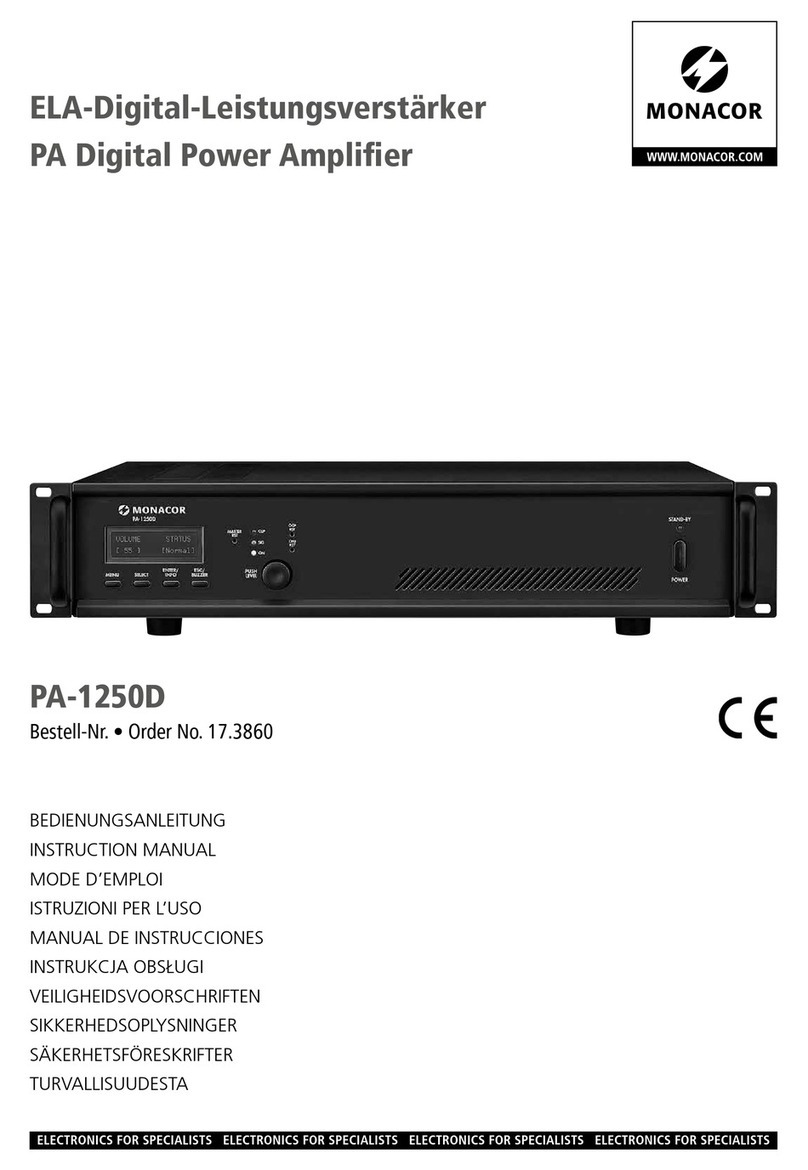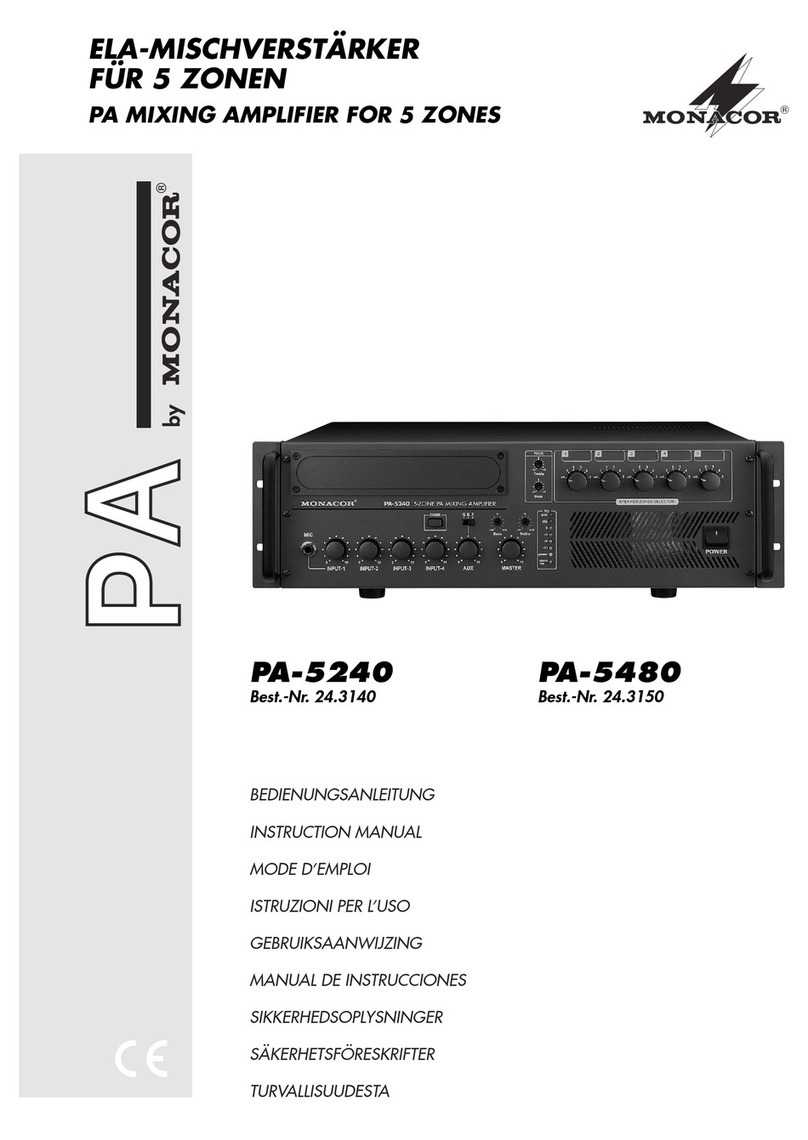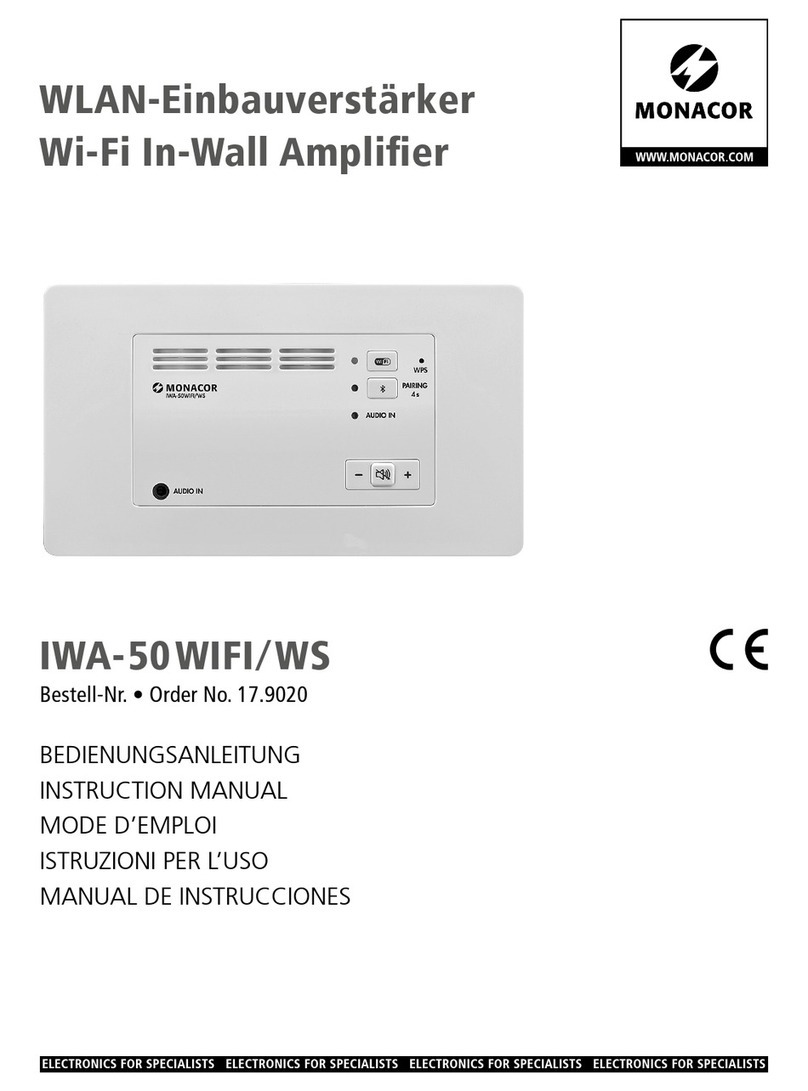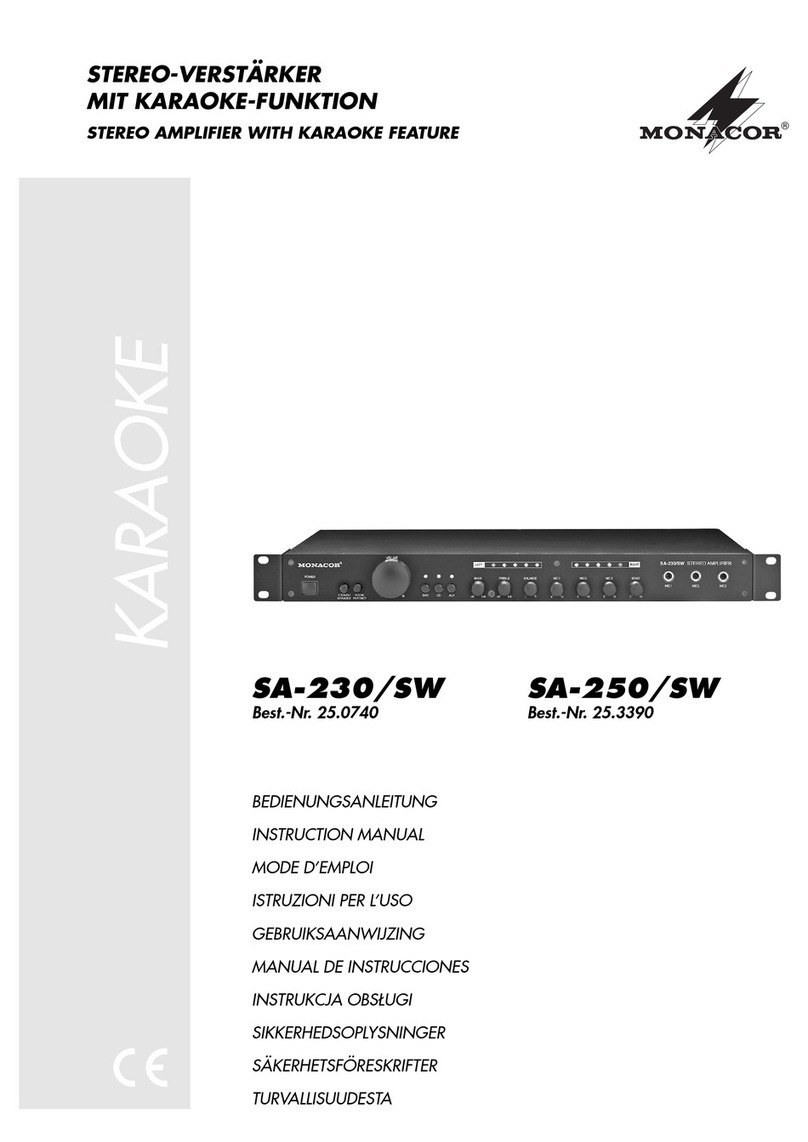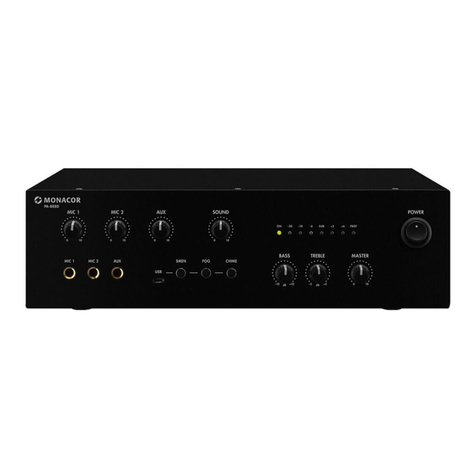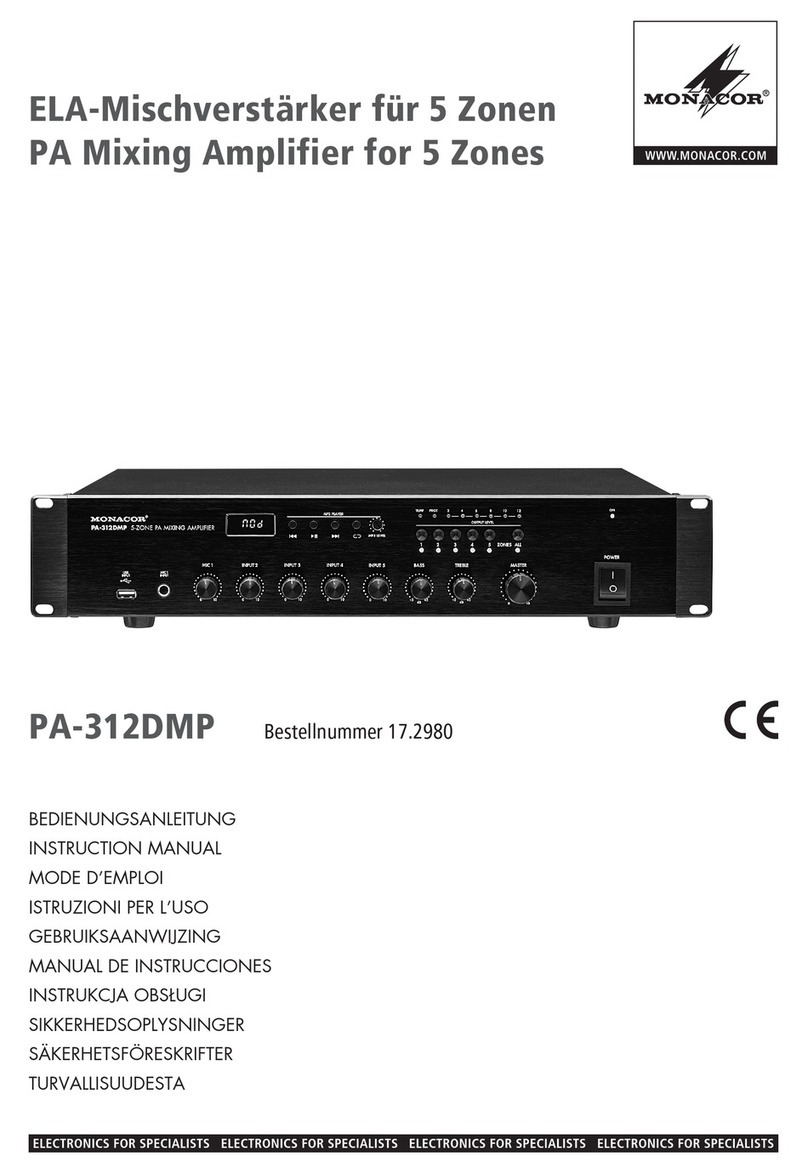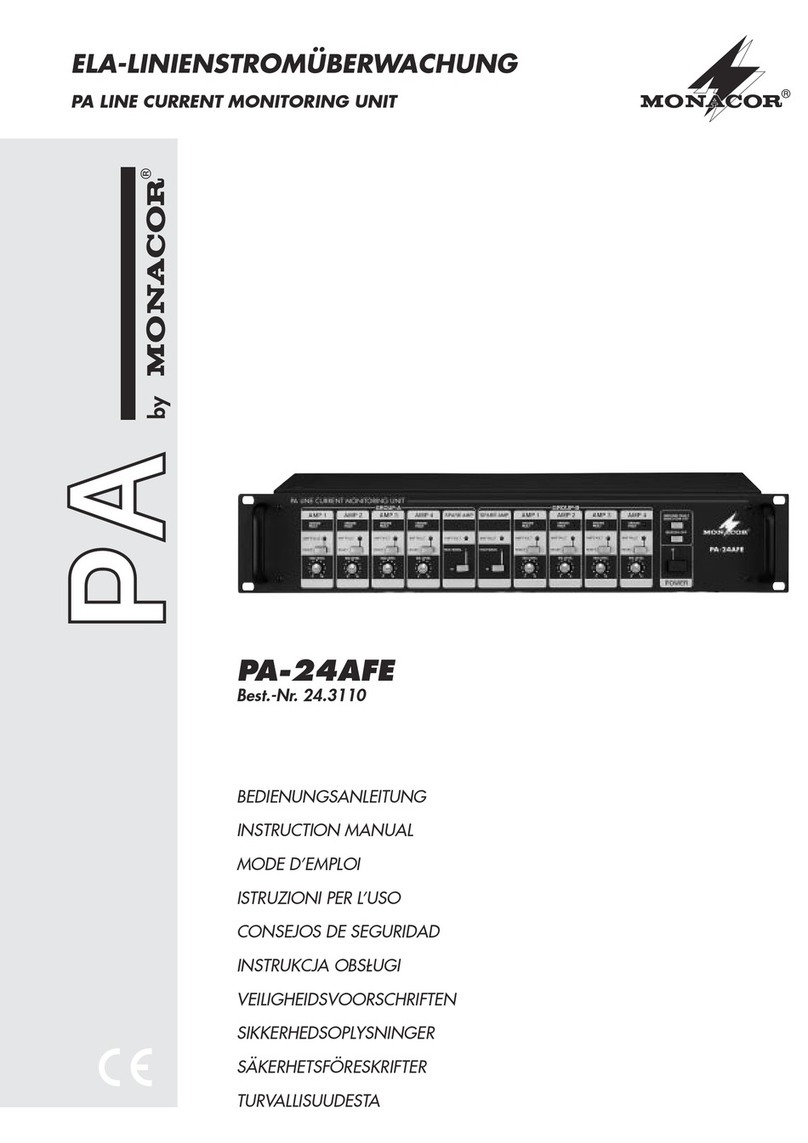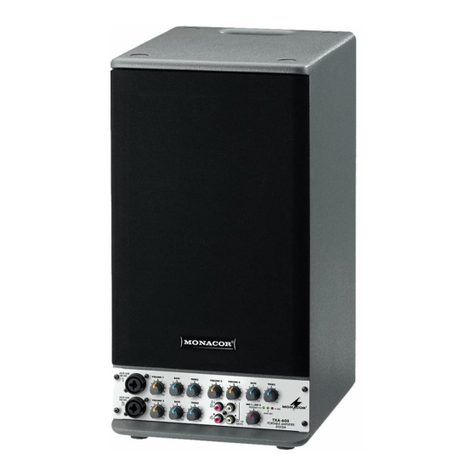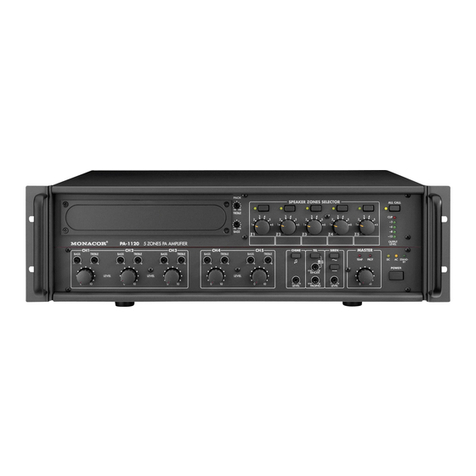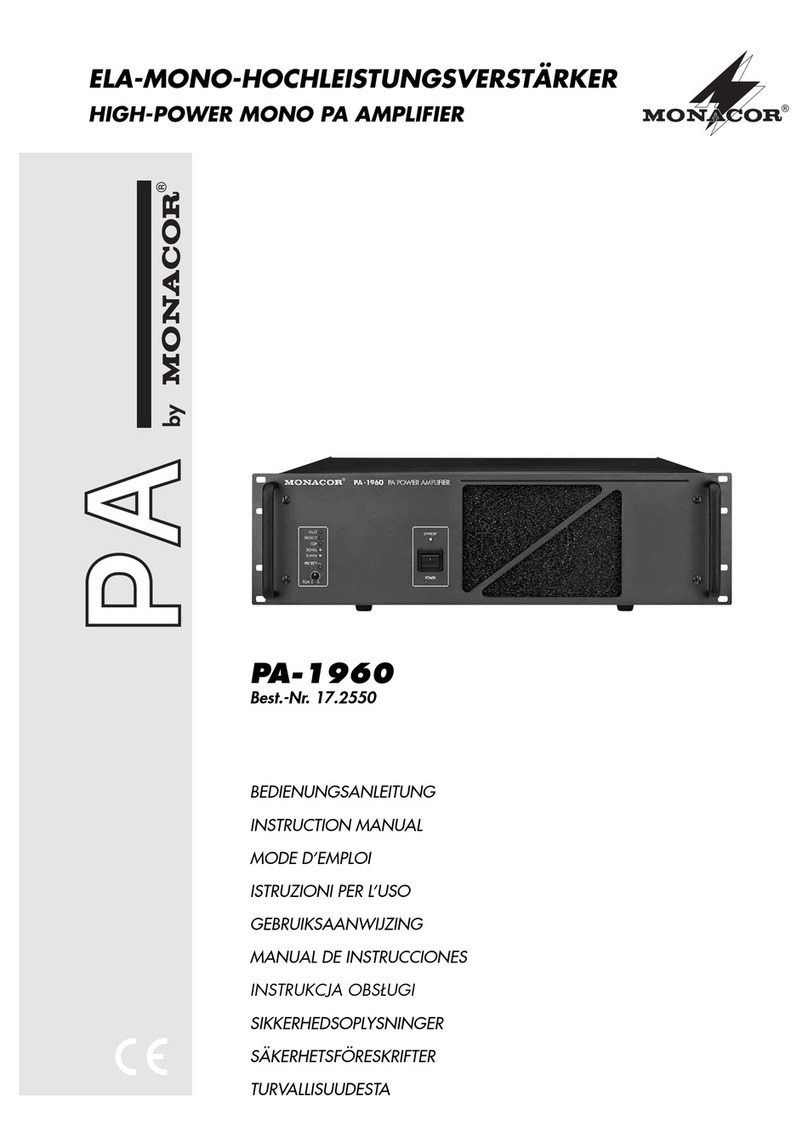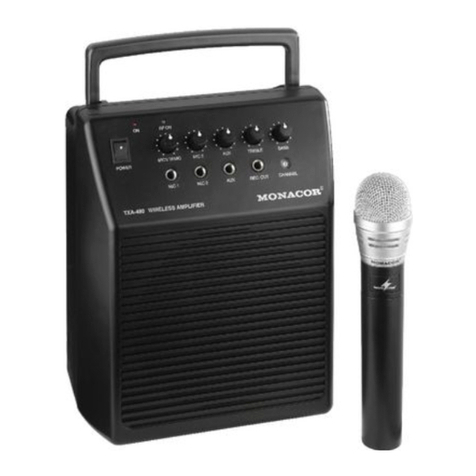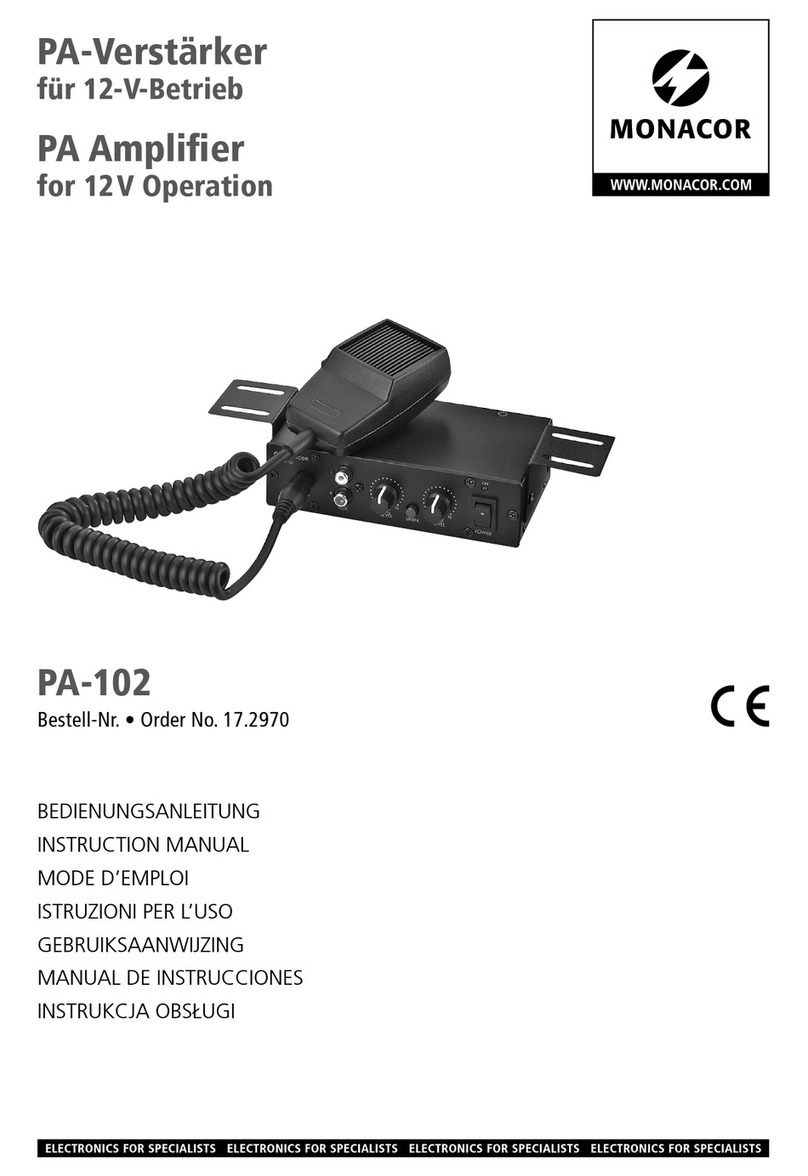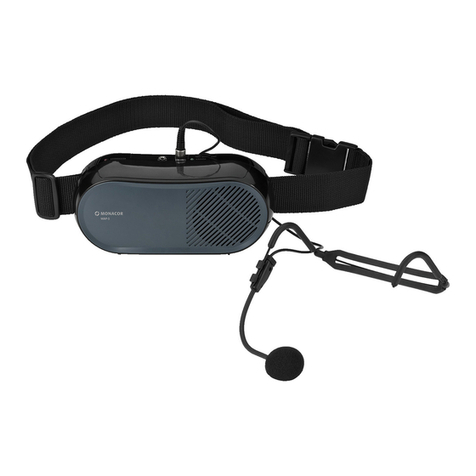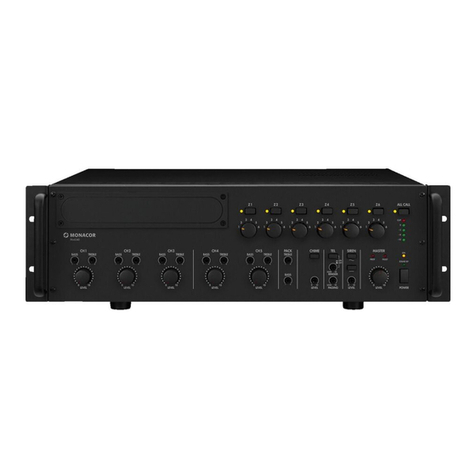2 Sicherheitshinweise
Die Endstufe entspricht der Kfz-Richtlinie.
GVerwenden Sie für die Reinigung nur ein trocke-
nes, weiches Tuch, auf keinen Fall Chemikalien
oder Wasser.
GWird das Gerät zweckentfremdet, nicht richtig an-
geschlossen, falsch bedient oder nicht fachgerecht
repariert, kann keine Haftung für daraus resultie-
rende Sach- oder Personenschäden und keine
Garantie für das Gerät übernommen werden.
3 Vorsicht bei hohen Lautstärken
GBei ausgeschaltetem Motor sollte die Car-HiFi-
Anlage nicht längere Zeit mit hoher Lautstärke
betrieben werden. Die Autobatterie wird schnell
entladen und liefert dann eventuell nicht mehr ge-
nügend Energie zum Starten.
4 Einsatzmöglichkeiten
Die Endstufe POWER-4/600 ist speziell für Car-
HiFi-Anlagen konzipiert und kann vier Full-Range-
Lautsprecher (2- oder 3-Wege-Lautsprecher) antrei-
ben. Durch die integrierten Frequenzweichen lässt
sich auch ein aktives 2-Wege-System mit zwei Mit-
telhochtönern und zwei Basslautsprechern oder
einem Subwoofer realisieren (Bi-Amping). Um eine
größere Ausgangsleistung zu erhalten, können die
Kanäle 1, 2 und/oder 3, 4 im Brückenbetrieb jeweils
einen 4-Ω-Lautsprecher antreiben.
5 Montage
Bei der Auswahl des Montageplatzes unbedingt die
folgenden Punkte beachten:
GDas 12-V-Stromversorgungskabel von der Batte-
rie zur Car-HiFi-Endstufe sollte so kurz wie mög-
lich sein. Es ist günstiger, längere Lautsprecher-
kabel zu verwenden und dafür ein kürzeres
Stromversorgungskabel.
GDie Masseleitung von der Endstufe zum Fahrzeug-
chassis sollte ebenfalls so kurz wie möglich sein.
GUm die entstehende Wärme der Car-HiFi-
Endstufe ableiten zu können, muss eine ausrei-
chende Belüftung gewährleistet sein.
GWegen der beim Bremsen auftretenden Kräfte
muss die Endstufe an einer mechanisch stabilen
Stelle fest angeschraubt werden.
GDie Sicherungen und die Regler müssen zugän-
gig sein.
GDie Endstufe sollte elektrisch isoliert vom Fahr-
zeugchassis montiert werden.
Die Endstufe über die vier Befestigungspunkte am
Kühlkörper an geeigneter Stelle festschrauben.
6 Endstufe anschließen
GDer Anschluss der Car-HiFi-Endstufe an das Bord-
netz darf nur durch qualifiziertes Fachpersonal
erfolgen.
GUnbedingt vor dem Anschluss die Minusklemme
der Autobatterie abschrauben, um bei einem
eventuellen Kurzschluss während der Installation
Schäden zu vermeiden.
GDie erforderlichen Kabel so verlegen, dass deren
Isolierung nicht beschädigt werden kann.
Verschiedene Anschlussmöglichkeiten sind in den
Abbildungen 3 – 6 auf der Seite 3 dargestellt.
6.1 Stromversorgung
6.1.1 Betriebsspannung
Den Anschluss „+12V“ (16) über ein entsprechendes
Kabel mit der Plusklemme der Autobatterie verbin-
den. Um den Spannungsverlust durch das Kabel
gering zu halten, sollte mindestens ein Querschnitt
von 20 mm2verwendet werden, z. B. CPC-200/RT*.
Um die neu verlegte 12-V-Leitung gegen einen Kurz-
schluss abzusichern, muss eine 100-A-Vorsicherung
in unmittelbarer Nähe der Batterie zwischengesetzt
werden (max. Kabellänge zur Batterie 20 cm).
Zur Stabilisierung der Betriebsspannung für die
Endstufe und der damit verbundenen Leistungsstei-
ger Zeit als nicht mehr so hoch. Erhöhen Sie
darum eine einmal eingestellte hohe Lautstärke
nach der Gewöhnung nicht weiter.
Während des Autofahrens dürfen Signaltöne, z. B.
von einem Rettungswagen, nicht durch eine zu hohe
Lautstärke der Car-HiFi-Anlage übertönt werden.
VORSICHT Stellen Sie die Lautstärke nie sehr
hoch ein. Extrem hohe Lautstärken
können das Gehör schädigen.
Das Ohr gewöhnt sich an hohe Laut-
stärken und empfindet sie nach eini-
WARNUNG Beim Anschluss der Car-HiFi-End-
stufe an die Autobatterie ist beson-
dere Sorgfalt geboten. Bei Kurz-
schlüssen können sehr gefährlich
hohe Ströme fließen. Schrauben Sie
deshalb unbedingt vor dem Anschluss
die Minusklemme der Autobatterie ab.
Die Endstufe muss fest und fachgerecht an einer
mechanisch stabilen Stelle im Auto montiert wer-
den, damit sie sich nicht löst und zu einem gefähr-
lichen Geschoss wird.
Während des Betriebs kann das Gerät sehr heiß
werden. Platzieren Sie darum keine hitzeempfind-
lichen Gegenstände in der Nähe und berühren Sie
die Endstufe nicht während des Betriebs.
Soll das Gerät endgültig aus dem Betrieb
genommen werden, übergeben Sie es zur
umweltgerechten Entsorgung einem örtli-
chen Recyclingbetrieb.
2 Safety Notes
The power amplifier corresponds to the directive for
automobiles.
GFor cleaning only use a dry, soft cloth, by no
means chemicals or water.
GNo guarantee claims for the unit and no liability for
any resulting personal damage or material damage
will be accepted if the unit is used for other pur-
poses than originally intended, if it is not correctly
connected or operated, or not repaired in an expert
way.
3 Caution in Case of High Volumes
GWith the motor switched off, the car HiFi system
should not be in operation at high volume for a
longer period of time. The car battery will quickly
be discharged, and then it may not be capable any
more of supplying sufficient energy for starting the
car.
4 Applications
The power amplifier POWER-4/600 has especially
been designed for car HiFi systems and is capable
of driving four full range speakers (2-way or 3-way
speakers). Due to the integrated crossover net-
works, it is also possible to realize an active 2-way
system with two mid-high range speakers and two
bass speakers or a subwoofer (bi-amping). To obtain
a higher output power, channels 1, 2 and/or 3, 4 can
drive one 4 Ω speaker each in bridge operation.
5 Mounting
When choosing the place of mounting, always
observe the following items in any case:
GThe 12 V power supply cable from the battery to
the car HiFi power amplifier should be as short as
possible. It is better to use longer speaker cables
and a shorter power supply cable instead.
GThe ground cable from the power amplifier to the
chassis of the car should also be as short as pos-
sible.
GFor carrying off the heat being generated by the
car HiFi power amplifier, a sufficient ventilation
has to be ensured.
GAs forces occur during braking, the power ampli-
fier must tightly be screwed to a mechanically sta-
ble place.
GThe fuses and the controls must be accessible.
GThe power amplifier should be mounted electri-
cally insulated from the car chassis.
Tightly screw the amplifier via the four fixing points
at the heat sink at a suitable place.
6 Connection of the Power Amplifier
GThe connection of the car HiFi power amplifier to
the electric system of the car must only be carried
out by qualified, specialized personnel.
GTo prevent damage in case of a possible short cir-
cuit during installation, prior to the connection it is
indispensable to screw off the negative terminal of
the car battery.
GLay the necessary cables so that their insulation
cannot be damaged.
Various connecting possibilities are shown in figs. 3
to 6 on page 3.
6.1 Power supply
6.1.1 Operating voltage
Connect the terminal “+12V” (16) via a correspond-
ing cable to the positive terminal of the car battery.
To keep the voltage loss by the cable as low as pos-
sible, a minimum cross section of 20 mm2should be
used, e. g. CPC-200/RT*. To protect the newly laid
12 V cable against a short circuit, insert an additional
100 A fuse very close to the battery (max. cable
length to the battery 20 cm).
To stabilize the operating voltage for the power
amplifier and thus the resulting power increase and
sound improvement, a power capacitor is recom-
mended (e. g. CAP-...*).
so high any more after some time. Therefore, do
not further increase a high volume which has once
been adjusted after getting used to it.
While driving in the car, signal sounds, e. g. by an
ambulance, must not be drowned by the volume of
the car HiFi system which has been adjusted too
high.
CAUTION Never adjust the volume very high.
Extremely high volumes may damage
your hearing.
The human ear gets accustomed to
high volumes which do not seem to be
If the unit is to be put out of operation defin-
itively, take it to a local recycling plant for a
disposal which is not harmful to the envi-
ronment.
WARNING When connecting the car HiFi power
amplifier to the car battery, be espe-
cially careful. In case of short circuits
there may be dangerously high cur-
rents. Therefore, prior to the connec-
tion, it is indispensable to screw off the
negative terminal of the car battery.
The power amplifier must be mounted to a me-
chanically stable place in the car. It must be skilful-
ly fixed so that it does not get loose and turn into a
dangerous projectile.
During operation the unit may become very hot.
Therefore, do not place any objects sensitive to
heat close to it and do not touch the power ampli-
fier while in operation.
5
GB
D
A
CH
* von CARPOWER
* by CARPOWER
